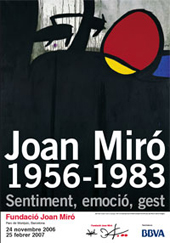- Dates
- —
After 1956, when Miró was finally able to start working in the studio designed for him in Palma by the architect Josep Lluís Sert, his art underwent considerable changes.At first, he stopped painting altogether. He worked hard to complete the ceramic murals for the Unesco building in Paris, which were unveiled in 1958, and he also had to organise things in his splendid new studio.
He spent a lot of time reviewing his earlier work,mainly the preparatory drawings accumulated over the years. He tore up quite a number of them,and others he used as the starting point for new projects.
With more space at his disposal, he was able to return to the large formats that he had found so satisfying when working on ceramic murals and mural paintings,and his plan now was to embark on large-format canvases.
Another factor that had a decisive effect on Miró’s work during the later years of his life was his first visit to Japan, in 1966. Although black had always been an essential colour for him in establishing the outlines of a composition, after this trip it took on a much more prominent role. Sometimes it was the principal feature of a painting, in a kind of calligraphic gesture.At other times it became an angry, aggressive statement.Probably the most obvious instance of this was his action in 1969 at the College of Architects in Barcelona, on the occasion of the “Miró otro” (The other Miró) exhibition there.
With his insatiable curiosity for exploring new paths, Miró also made use of fire, an element that he was well acquainted with after having worked on ceramics, in order to produce new textures and forms in his paintings and textiles. He used it, too, to show his scepticism at the commercialisation of art and its paradoxes.
Whether ironic, punchy and unrestrained, with skilful control of the colour fields and the large format, or violent and aggressive in his use of black, Miró expressed himself through his painting in his later years in the same way as he had always done. As far back as the late 1920s, when talking about assassinating painting, he had precisely said that this was the only weapon he possessed. It was also the tool that he used in his old age to call for justice or to assist some humanitarian cause. But this did not prevent him from maintaining the characteristic poetic force of his art.


